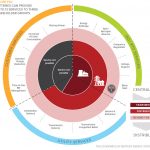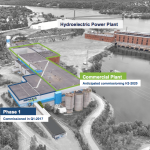Arotech Receives Additional Research Funding of $650,000 from U.S. Army
Arotech Corporation (ARTX) announced that its Battery and Power Systems division has received additional funding from the U.S. Army's Communications and Electronics Command, CECOM, for further development of its 4th generation (Gen4) zinc-air cells. The funding covers Phase II of a three-phased research and development program for Gen4 Zinc-Air Cells aimed at the Future Force Warrior project - the U.S. Army's flagship Science and Technology initiative to develop and demonstrate revolutionary capabilities for Future Force soldier systems. Arotech's Gen4 portable battery pack is 12 or 24 Volts and has a total capacity exceeding 400Wh with Battery Energy Density above...
Solar & Storage Finance Conference Notes
I attended the Solar & Storage Finance conference hosted in NYC in late October 2018. Presenters included a mix of capital providers & asset managers, private non-profit entities & public agencies, legal, accounting & consulting firms, intermediaries, firms providing risk analysis, ratings & mitigation, & various vendors of energy storage and IT-related services. The tone of the discussions was noteworthy for its near total absence of ideological comments about environmental urgency. Rather, it was a meeting of finance technicians and technocrats focused on the nuts & bolts of accomplishing those ends, with the merits and relevance of mission assumed.
The...
The Race For Silicon Anodes
Graphite is the most widely used material for battery anodes. The anode is the positively charged electron collector in a battery. It collects and accelerates the electronics emitted by the battery’s cathode. Graphite gets the anode job because it is has excellent electric conductivity and resists heat and corrosion. Plus it is light weight, soft and malleable.
As satisfied as manufacturers might be with graphite anodes, none would balk at an alternative material that boosts battery performance or reduces cost. Scientists believe battery capacity can be increased as much as ten times by using silicon for anodes. It requires six atoms of carbon to bind one...
Nemaska: A Lithium Bargain
Nemaska Lithium (NMKEF: OTC/PK, NMX: TO) is a newcomer to the lithium industry. The company recently came to the market with battery-grade lithium from spodumene rock carved out of its Whabouchi mine in northern Quebec, Canada and converted in a proprietary electrochemical process to battery-grade lithium material at an in-house facility in Shawinigan to the south. The company filled its first orders in Summer 2018.
The company expected to produce over 200,000 metric tons of lithium-bearing spodumene concentrate from its Whabouchi mine with an average 6.25% lithium oxide content. The mine is expected to remain productive for over three decades at that extraction rate. The processing plant in...
Graftech Takes a Leg Down
by Debra Fiakas CFA Shares of graphite producer Graftech International (GTI: NYSE) took another long step downward in trading earlier this week, extending a lengthy slide since the beginning of the year. The shares have attempted a comeback at least twice, but with no success. GTI has sunk back near its three-year low. For contrarian investors, this is a good time to take a new look at Graftech - a company that has become habitually profitable. After successive losses in the difficult economic period that ensued just after the start of the new millennium, Graftech management regained...
Nemaska Sprints to Early Lead In Lithium Mining Race
Thank Elon Musk with his Tesla (TSLA) gigafactory for sparking a global obsession with lithium-ion batteries and the materials need to turn them out. Claimed by Musk to be the largest building in the world, the factory was planned to reach capacity in stages. By the time the factory is fully completed in 2020, production capacity is expected to be 150 gigawatt hours of battery packs.
Ever since construction of Musk’s gigafactory began in 2014, investors around the world have been fretting over the adequacy of lithium supplies in particular. The gigafactory concept appeared to trigger a whole slew of ‘me too’ factories...
Electric Vehicle and Lithium-ion Battery Investing For Imbeciles
John Petersen In their 1969 bestseller "The Peter Principle" Laurence Peter and Raymond Hull quoted a Latin-American student named Caesare Innocente who lamented, "Professor Peter, I'm afraid that what I want to know is not answered by all my studying. I don't know whether the world is run by smart men who are, how you Americans say, putting us on, or by imbeciles who really mean it." After watching the events of the last few weeks, I think most of my regular readers would agree that the imbeciles are clearly steering the ship. Last March I went...
Maxwell’s Earnings Restatement: Some Good, Some Bad, No Ugly
Tom Konrad CFA When Maxwell Technologies (NASD:MXWL) announced problems with its revenue accounting on March 7h, I took a look at the company’s reported Accounts Receivable (where early revenue recognition usually shows up) and concluded that management had underestimated the scope of the accounting problems. Convinced that there was more to come, I not only sold the stock, but took a short position. On August 1st, Maxwell filed its restated annual reports for 2012 (including restatements of 2011), as well as statements for the first two quarters of 2013. The Bad News:...
Arotech’s Batteries and Power Systems Division to Develop Zinc-Air Batteries for UAVs for Major...
Arotech Corporation (ARTX) announced that its Batteries and Power Systems Division has received a second development contract from a major US agency. Under the contract, Arotech's Electric Fuel Battery Corporation subsidiary will develop prototype zinc-air batteries for small unmanned aerial vehicles (UAVs) to achieve extended flight times. The funding is expected to cover development costs.
Grid-based Energy Storage: Widely Misunderstood Challenges and Opportunities
John Petersen The most widely misunderstood subject in the field of energy storage is the potential for grid-based applications. They fire the imagination because the grid is so pervasive and the need is so great. They also present immense challenges to storage technology developers because the fundamental economic value per unit of grid-based energy storage is very low. While the subject of grid-based storage provides rich fodder for media reports and political posturing, the reality bears little relation to the perception. On March 9th, Lux Research published a sorely needed reality check in a new report titled "Grid...
Electric Vehicles; Ineptitude, apathy … and piles of taxpayer money
John Petersen The last few weeks have been a media and political circus in the US as a pair of high-profile Department of Energy loan guarantees wound up in bankruptcy court. In the first case, solar power innovator Solyndra filed two years after closing a $535 million loan for a factory that never quite made it into production. In the second case, flywheel storage innovator Beacon Power (BCONQ.PK) filed about a year after scoring a $43 million loan for a 20 MW frequency regulation plant that was commissioned in June. Both are black eyes for the Obama administration’s...
Pure Play Energy Storage Stocks Year-End Review And Outlook
John Petersen With only a couple trading days left in 2009, this is as good a time as any for a performance review. The predictions I made at this time last year were pretty solid with an 80% accuracy rate on price direction. For the year, a $1,000 investment in each of my green star companies would have yielded a portfolio appreciation of 67%, which handily beat the broader market indices. That being said, my star and caution ratings were a good deal less prescient because I seriously underestimated the potential of both Maxwell Technologies (MXWL) and Active...
Investment Ideas From the One-House Grid
In June, I wrote how intermittent power sources such as photovoltaics and wind would have to compete with baseload technologies such as IGCC "Clean Coal" and nuclear for capacity on the grid. The key problem is that neither baseload technologies nor intermittent technologies are able to match themselves to the fluctuations of demand. This creates a need for technologies which can fill the varying gaps between supply from these sources, and normal energy use. From the comments, it seems like I was not completely clear how intermittent and baseload power cause problems for each other, so I will start...
Automotive Batteries, Short-term Revenue Growth Favors Lead-acid By 6 To 1
Last week, an article in Green Car Congress summarized a market forecast that Dr. Menahem Anderman presented at this month's Advanced Automotive Battery Conference in Long Beach, California. In his presentation, Dr. Anderman evaluated the market for HEVs in 2011, projected a $1,230 million market for automotive NiMH batteries, and projected a $320 million market for automotive Li-ion batteries. The following graph comes from Green Car Congress, is based on data from Dr. Anderman's AABC presentation, and shows both unit sales and market value of the Li-ion batteries that will be used in HEVs by 2011 (click on the...
Alice in EVLand – Cracks in the Looking Glass
John Petersen In his 2006 State of the Union Address, President George W. Bush said: "Keeping America competitive requires affordable energy. And here we have a serious problem: America is addicted to oil, which is often imported from unstable parts of the world. The best way to break this addiction is through technology." What a crock of balderdash! If you compare US fuel prices with those in other industrialized countries, gasoline is a screaming bargain and the same can be said for electricity. It's not the energy we use that's a problem. The problem is the...
Lithium-ion Batteries Are Too Valuable To Waste On Plug-in Vehicles
John Petersen In November 2006, a slick issue-oriented documentary asked the provocative question "Who Killed the Electric Car" and argued that General Motors' EV1 project was terminated because of collusion between the auto and oil industries. The truth is nobody killed the electric car. It died in infancy from congenital birth defects and the same flaws that killed the EV1 will probably kill Tesla Motors, Fisker Automotive, Nissan's (NSANY) Leaf and GM's Volt. This is not a question of cost, performance, abuse tolerance or cycle-life. It's a fundamental flaw in the economics of using batteries to replace a...






